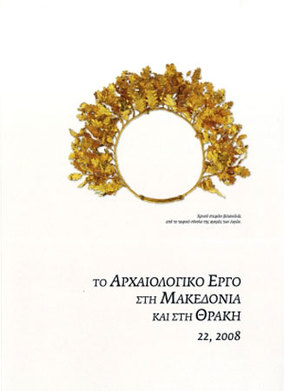Επτά χρόνια (1990-1996) αρχαιολογικών ερευνών στη διπλή τράπεζα Αγχιάλου-Σίνδου : ο αρχαίος οικισμός
Part of : Το Αρχαιολογικό Έργο στη Μακεδονία και στη Θράκη ; Vol.10, No.Α, 1996, pages 407-425
Issue:
Pages:
407-425
Parallel Title:
Seven years (1990-1996) of archaeological research on the site of the double «trapeza» at Anchialos/Sindos : the ancient settlement
Author:
Abstract:
The University of Thessaloniki’s excavation of the ancient settlement located above a double «trapeza» in the vicinity of the modern village of Sindos began in 1990. To date a number of sites in both the upper and the lower trapezae have been explored. In the upper trapeza an area 2x4 m by ap proximately 16 m deep was excavated. In this section the strata were for the most part undisturbed. Although the earliest human presence here dates from the Late Bronze Age, potsherds from the Late Neolithic Period were also identified. The settlement developed on an elevation created by a thick deposit of sand. Building remains included a two-level horseshoe-shaped cooking oven from the Late Mycenaean period, ruins from a variety of ages, remnants of a bronzesmith’s workshop from the 9th century BC, and oval hearths with brick spit-frames from about 800 BC. Of the other artifacts the most notable were considerable quantities of local and imported pottery, including remarkable quantities of geometric pottery from Southern Greece, Euboea in particular. Found an another site on the upper trapeza were an extensive storehouse from the Archaic period and a monumental terrace from the so-called Iron Age, built up mainly of successive layers of yellow mud.The lower trapeza revealed dump deposits filled mainly with fine pottery, some inscribed, and a variety of domestic areas with workshops and cooking facilities with ovens and square or P-shapped hearths. These various areas were separated by brick walls ans date from the geometric period, while the dump deposits were used during a variety of periods (6th-4th century).Towards the end of the 4th century BC the settlement suffered a marked decline, probably associated with the founding nearby of Cassander’s new city of Thessalonica. It is extremely likely that this settlement, which may have been Ancient Sindos, was one of the 26 towns co-opted into the synoecismos of Thessalonica. Throughout the geometric, archaic and classical periods one of its principal sources of revenue must have been the gold from the nearby Gallikos river, the Echedorus of the ancients. Here in the 8th century BC the Euboeans may have founded a trading post. The settlement developed contacts, direct and indirect, with many parts of the ancient world, while from a very early date its inhabitants were acquainted with the art of metal-working. As an important centre, especially during the geometric age, this site also developed an extensive pottery production. During the 7th century BC the settlement was confined to the upper trapeza, while the lower was used chiefly for disposing of waste material.
Subject:
Subject (LC):
Keywords:
Χαλκιδική, συνέδρια
Notes:
Περιέχει κατόψεις, σχέδια και εικόνες, Το άρθρο είναι αφιερωμένο στη μνήμη του Ι. Βοκοτόπουλου




